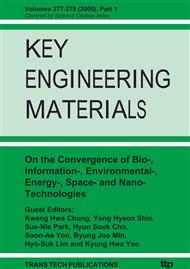p.966
p.972
p.977
p.983
p.990
p.995
p.1000
p.1006
p.1011
Enhanced Sensitivity of the Pirani Vacuum Gauge by the AC Driving Method
Abstract:
We improved the sensitivity of existing commercial Pirani-vacuum gauges employing the AC method in the vacuum range above 1 Torr. The signals obtained through the use of the AC method yield information related to the specific heat and heat conductivity of gas. The output signal is obtained by two components: the oscillating temperature amplitude, and its phase. The amplitude increases with the decrease of pressure in the vacuum range from the atmosphere to about 1 Torr, which arises from the decrease of the heat capacity with the decrease of gas density. In contrast, the phase decreases monotonically as pressure decreases and the slop of a dΘ/d(log P) is large at higher than 1 Torr. This provides a good advantage for developing a new Pirani gauge with high sensitivity.
Info:
Periodical:
Pages:
990-994
Citation:
Online since:
January 2005
Authors:
Price:
Сopyright:
© 2005 Trans Tech Publications Ltd. All Rights Reserved
Share:
Citation:


